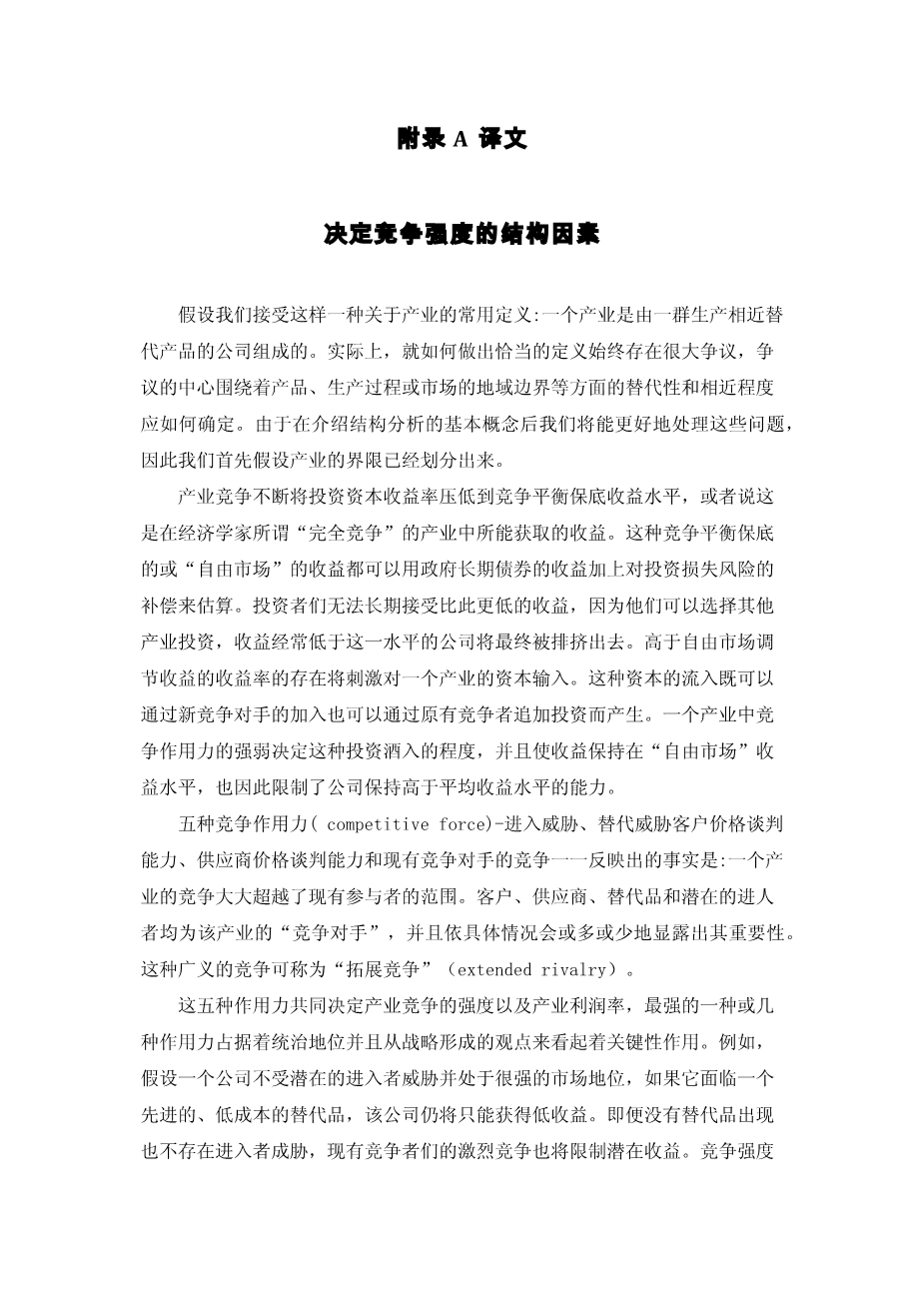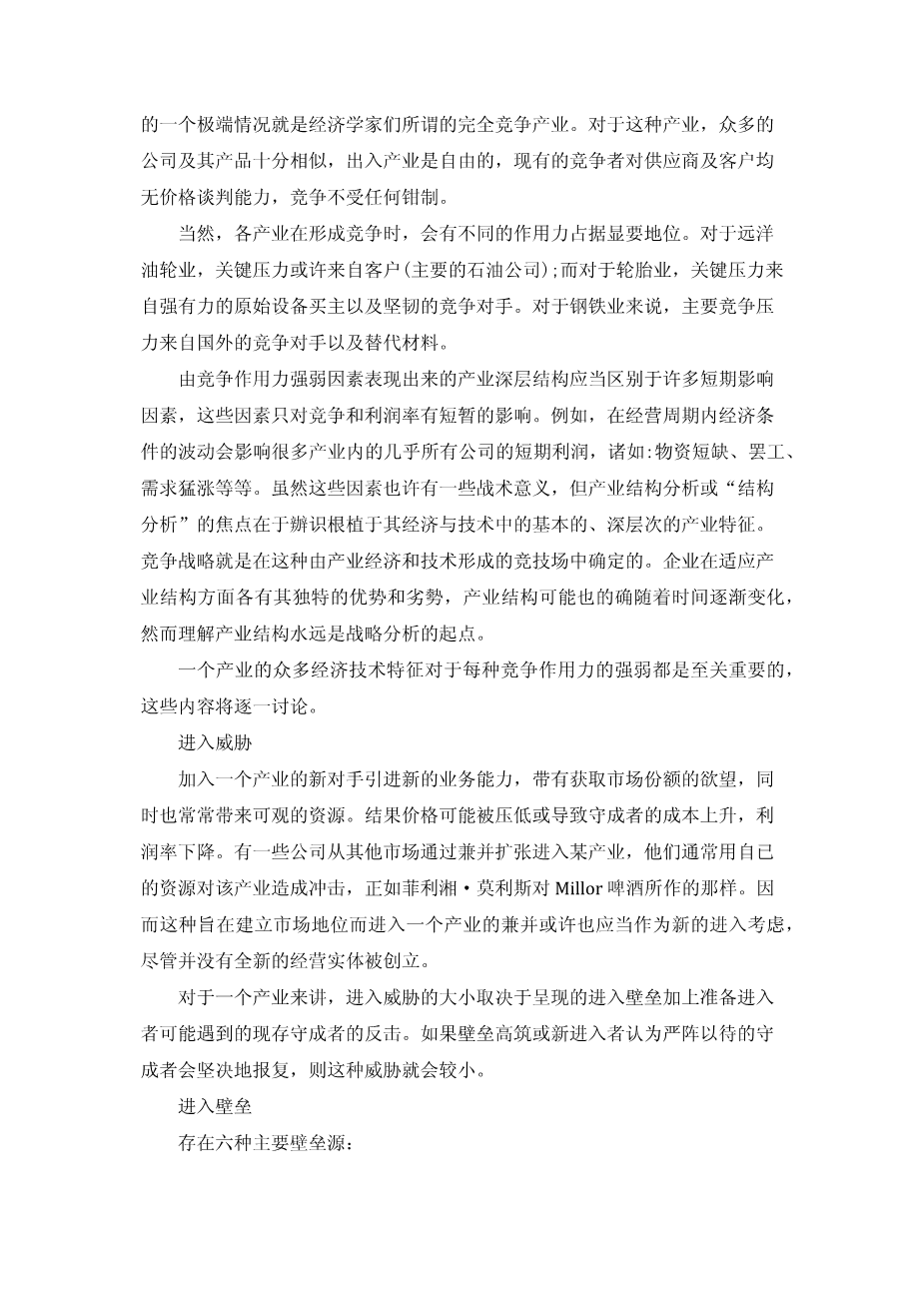Structural Determinants of the Intensity of Competition
Let us adopt the working definition of an industry as the group of firms producing products that are close substitutes for each other.In practice there is often a great deal of controversy over the appropriate definition,centering around how close substitutability needs to be in terms of product, process, or geographic market boundaries.Because we will be in a better position to treat these issues once the basic concept of structural analysis has been introduced, we will assume initially that industry boundaries have already been drawn.
Competition in an industry continually works to drive down the rate of return on invested capital toward the competitive floor rate of return, or the return that would be earned by the economistslsquo;perfectly competitiversquo; industry. This competitive floor, or lsquo;free marketrsquo;return, is approximated by the yield on long-term government securities adjusted upward by the risk of capital loss, Investors will not tolerate returns below this rate in the long run because of their alternative of investing in other industries, and firms habitually earning less than this return will eventually go out of business. The presence of rates of return higher than the adjusted free market return serves to stimulate the inflow of capital into an industry either through new entry or through additional investment by existing competitors.The strength of the competitive forces in an industry determines the degree to which this inflow of investment occurs and drives the return to the free market level, and thus the ability of firms to sustain above-average returns
The five competitive forces-entry, threat of substitution, bargaining power of buyers, bargaining power of suppliers, and rivalry among current competitors-reflect the fact that competition in an industry goes well beyond the established players. Customers, suppliers, substitutes, and potential entrants are allrsquo;competitorsrsquo;to firms in the industry and may be more or less prominent depending on the particular circumstances. Competition in this broader sense might be termed extended rivalry.
All five competitive forces jointly determine the intensity of industry competition and profitability, and the strongest force or forces are governing and become crucial from the point of view of strategy formulation. For example, even a company with a very strong market position in an industry where potential entrants are no threat will earn low returns if it faces a superior, lower-cost substitute.Even with no substitutes and blocked entry, intense rivalry among existing competitors will limit potential returns. The extreme case of competitive intensity is the economists perfectly competitive industry, where entry is free, existing firms have no bargaining power against suppliers and customers, and rivalry is unbridled because the numerous firms and products are all alike.
Different forces take on prominence, of course, in shaping competition in each industry. In the ocean-going tanker industry the key force is probably the buyers (the major oil companies), whereas intires it is powerful original equipment(OEM) buyers coupled with tough competitors. In the steel industry the key forces are foreign competitors and substitute materials.
The underlying structure of an industry, reflected in the strength of the forces, should be distinguished from the many short-run factors that can affect competition and profitabilility in a transient way. For example, fluctuations in economic conditions over the business cycle influence the short-run profitability of nearly all firms
in many industries, as can material shortages, strikes, spurts in demand, and the like. Although such factors may have tactical significance, the focus of the analysis of industry structure, orrsquo;structural analysisrsquo;, is on identifying the basic, underlying characteristics of an industry rooted in its economics and technology that shape the arena in which competitive strategy must be set. Firms will each have unique strengths and weaknesses in dealing with industry structure, and industry structure can and does shift gradually over time. Yet understanding industry structure must be the starting point for strategic analysis.
A number of important economic and technical characteristics of an industry are critical to the strength of each competitive force.These will be discussed in turn.
THREAT OF ENTRY
New entrants to an industry bring new capacity, the desire to gain market share, and often substantial resources. Prices can be bid down or incumbents costs inflated as a result, reducing profitability. Companies diversifying through acquisition into the industry from other markets often use their resources to cause a shake-up, as Philip Morris did with Miller beer. Thus acquisition into an industry with intent to build market position should probably be viewed as entry even though no entirely new entity is created.
The threat of entry into an industry depends on the barriers to entry that are present, coupled with the reaction from existing competitors that the entrant can expect, If barriers are high and/or the newcomer can expect sharp retaliation from entrenched competitors the threat of entry is low.
There are six maior sources of barriers to entry:
Economies of Scale. Economies of scale refer to declines in unit costs of a product(or operation or function that goes into producing a product)as the absolute volume per period increases. Bconomies of scale deter entry by forcing the entrant to come in at large scale and risk strong reaction from existing firms or come in at a small scale and accept a cost disadvantage, both undesirable options, Scale economies can be present in nearly every function of a business, including manufacturing, purchasing, research and development, marketing, service network, sales force utiliz
剩余内容已隐藏,支付完成后下载完整资料


英语译文共 4 页,剩余内容已隐藏,支付完成后下载完整资料
资料编号:[444588],资料为PDF文档或Word文档,PDF文档可免费转换为Word


